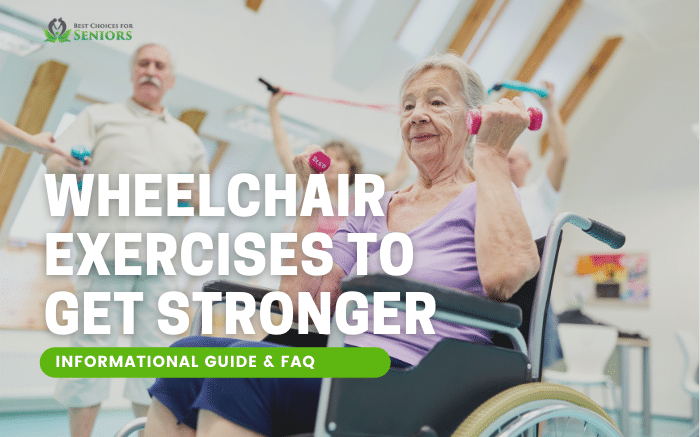The fact that exercise helps improve fitness is a well-known one.
However, what only a few fully grasp is that exercising also helps mitigate stress, improve the mood, and enhance day-to-day life in general in many ways.
Exercise for elderly in wheelchairs is equally important for all these benefits. It’s not just about fitness, it’s about boosting one’s mood and achieve a better life.
Just because you’re in a wheelchair doesn’t mean you cannot do exercises!
In this piece, we’re going to outline several exercises that are hassle-free and comfortable to do for elderlies in the wheelchair.
Things to keep in mind before you begin
Exercise for elderly in wheelchairs isn’t without its demands. You have to keep several things in mind:
- Reps, or repetitions, are the number of times you do a particular exercise. Make sure you don’t do more than 4-5 reps in the beginning. If and when you feel completely comfortable going higher than 4-5 reps, you can slowly increase the number.
- The intensity of the exercise should be kept low. These are not full-fledged workouts and you’re not working on bodybuilding. Fitness exercises are meant to have some leeway in terms of their intensity.
- Always sit straight, keep your muscles relaxed, and stay firm before beginning the exercises. Try to keep the other parts of the body not involved in the exercise as stationary and motionless as possible.
Pull apart (with resistance band)
Your back (and especially the lower back) is a key aspect of your core strength. Many seniors struggle with back problems. Pull apart exercises allow you to strengthen the back, and as a result, the entire core of your body.
The process:
- Keep the hands at least a couple of feet apart from each other. Grab the middle part of the resistance band with both hands.
- Pull the shoulder blades together so that the arms come apart. Keep the shoulders down.
- Stretch the band by opening the arms as far wide as possible for you. The checkpoint here is to open them all the way to the sides.
- Steadily return to the original position.
Forward bends
Not all exercises are nearly as effective when done from a seating position. Forward bends are a clear exception. They’re even more effective if you do them seated, making them the ideal strength exercise for elderlies in the wheelchair.
Forward bends will improve the spine, neck, and shoulder flexibility, which in turn improves the overall fitness of your body.
The process:
- Drop the torso to reach the thighs.
- Make sure there’s an even, steady curl in your spine as you drop forward.
- Your arms should weigh down on your body as if trying to reach the ground.
- Bend as much as possible while keeping your posture steady and hold in this position for at least 20 seconds.
- Move back to the original position slowly.
Twists
Twists are great for seniors. They help you tighten the sides (especially the oblique muscles). Additionally, they also work as a great cardio exercise, meaning that doing more of these and with higher intensity will allow you to reap significantly better benefits.
Twists will get the blood flowing and a feeling of tiredness is common. Start with several minutes of twists.
The process:
- Sit relaxed. Bending your elbows, slowly lift your hands up in front of the chest. Keep the palms facing outwards, while the fingers point up.
- Point the knees on one side of the wheelchair. Only go as far as your body’s mobility allows.
- Tighten your core and twist the torso in the opposite direction of the knees.
- Return to the original position and alternate the sides.
Knee to the chest
Knee to the chest is an amazing exercise for those who struggle with arms, shoulders, core, and hamstring problems. This exercise will strengthen these parts while adding to your body’s overall flexibility. Knee to the chest is one of the more taxing exercises, so find out your limits and start slow.
The process:
- Hold the back of your thigh with both your hands.
- Tighten your core and keep it braced.
- Now, it’s time to lift one of your legs as high as your body allows.
- Hold in this position for some time.
- Repeat on the other leg.
Bonus exercise: Wheelchair pushups
Wheelchair pushups aren’t for everyone. Talk with your caregiver or physician about whether or not you should be doing these. Depending on underlying health issues, body mobility, and your age, wheelchair pushups might or might not be recommended for you.
As a general rule of thumb, if your body has plenty of elasticity and strength to do a light pushup, then wheelchair pushups might be the most beneficial strength-building exercise for you.
The areas a wheelchair pushup works on are the chest, shoulders, and arms. Make sure you’re in a strong wheelchair.
The process:
- Grip the armrests tightly.
- Keep your core muscles tightened.
- Use your arms to push your body up. Lift your body off the seat and go as high as possible, while maintaining a rigid posture.
- Hold in this position for several seconds.
- Lower your body into the seat. Do it slowly. Don’t fall into the chair, use your arms to slowly reposition yourself.
Final thoughts
Only a combination of various types of exercises can have great results. Some of the exercises we’ve talked about increase the body’s strength (like the pull apart), some are cardiovascular (like the twists), while some are meant to improve the body’s flexibility (like the forward bends).
Try a few and make your own customized routine of exercises and their number of reps for the best results. And remember to stick to this routine.
Happy exercising!

